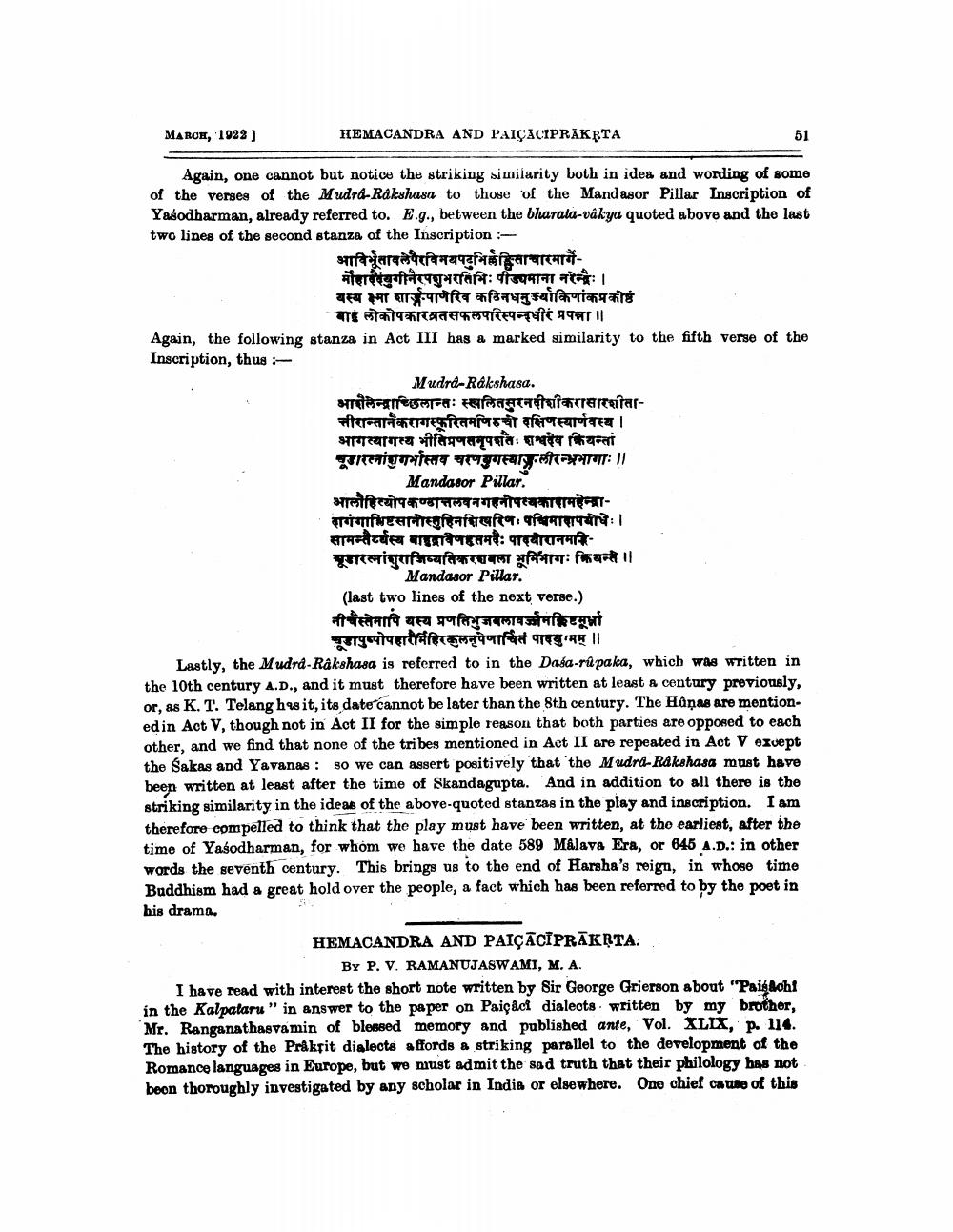________________
MARCE, 1922]
HEMACANDRA AND PAIÇACIPRÄKRTA
51
Again, one cannot but notice the striking similarity both in idea and wording of some of the verses of the Mudrd-Rakshast to those of the Mand asor Pillar Inscription of Yasodharman, already referred to. E.g., between the bharata-vákya quoted above and the last two lines of the second stanza of the Inscription :
आविर्भूतावलेपैरविमयपटुभिल्लड्डिताचारमार्गमोहायुगीनरपशुभरतिभिः पीज्यमाना नरेन्द्रः । बस्य मा शापाणेरिव कठिनधनुयाकिणांकप्रकोष्ठं
बाई लोकोपकारवतसफलपरिस्पन्नधीरं प्रपन्ना॥ Again, the following stanza in Act III has a marked similarity to the fifth verse of the Inscription, thus:
Mudrd-Rakshasa. भाशैलेन्द्राच्छिलान्तः स्खलितसुरनदीशीकरासारशीतातीरान्तानकरागस्फुरितमणिरुची दक्षिणस्यार्णवस्थ । आगत्यागस्य भीतिप्रणसमृपतेः शश्वदेव कियन्तां चूनारत्नांशुगर्भास्तव चरणबुगस्याउलीरन्ध्रभागाः॥
Mandasor Pillar. आलौहित्योपकण्ठानलवनगहनोपस्वकाशमहेन्द्राबागंगालिष्टसानोस्तुहिनशिखरिणः पचिमाशपयोधेः। सामन्तैयस्थ बाहद्रविणहतमः पादयोरानमदिभूगरलांशुराभिव्यतिकरधवला भूमिभागः क्रियन्ते ।।
Mandasor Pillar. (last two lines of the next verse.) नीचैस्तेमापि यस्य प्रणतिभुजबलावज्जेमकिष्टमूर्धा
चूडापुष्पोपहारमिहिरकुलनृपेणार्चितं पादयुग्मम् ।। Lastly, the Mudra-Rakshasa is referred to in the Dasa-rupaka, which was written in the 10th century A.D., and it must therefore have been written at least a century previously, or, as K. T. Telang hus it, its date cannot be later than the 8th century. The Hüņas are mentioned in Act V, though not in Act II for the simple reason that both parties are opposed to each other, and we find that none of the tribes mentioned in Act II are repeated in Act V except the Sakas and Yavanas : so we can assert positively that the Mudrd-Rakshasa must have been written at least after the time of Skandagupta. And in addition to all there is the striking similarity in the ideas of the above-quoted stanzas in the play and inscription. I am therefore compelled to think that the play must have been written, at the earliest, after the time of Yasodharman, for whom we have the date 589 Málava Era, or 645 A.D.: in other words the seventh century. This brings us to the end of Harsha's reign, in whose time Buddhism had a great hold over the people, a fact which has been referred to by the poet in his drama
HEMACANDRA AND PAIGĀCIPRĀKRTA.
By P. V. RAMANUJASWAMI, M. A. I have read with interest the short note written by Sir George Grierson about "Paisloh in the Kalpataru " in answer to the paper on Paiçact dialects written by my brother, Mr. Ranganathasvamin of blessed memory and published ante, Vol. XLIX, p. 114. The history of the Pråkpit dialects affords a striking parallel to the development of the Romance languages in Europe, but we must admit the sad truth that their philology has not been thoroughly investigated by any scholar in India or elsewhere. One chief catuite of this




